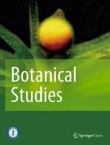Citation Impact 2023
Journal Impact Factor: 4.1
5-year Journal Impact Factor: 3.8
Source Normalized Impact per Paper (SNIP): 1.405
SCImago Journal Rank (SJR): 0.740
Speed 2023
Submission to first editorial decision (median days): 20
Submission to acceptance (median days): 114
Usage 2023
Downloads: 388,267
Altmetric mentions: 226
Camellia neriifolia and Camellia ilicifolia (Theaceae) as separate species: evidence from morphology, anatomy, palynology, molecular systematics
The systematic status of sect. Tuberculata and its taxonomy have recently attracted considerable attention. However, the different bases for defining the characteristics of sect. Tuberculata has led to many disag...
